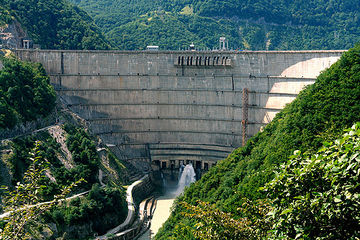Hydroelectric dam

A hydroelectric dam is one of the major components of a hydroelectric facility. A dam is a large, man-made structure built to contain some body of water. In addition to construction for the purpose of producing hydroelectric power, dams are created to control river flow and regulate flooding.[2]
Dams fall into the category of retaining structures, or structures that are built to create large standing bodies of water known as reservoirs. These reservoirs can be used for irrigation, electrical generation, or water supply. These structures are built on top of riverbeds and hold back water, raising the water level. Dikes can be built along with the dam to increase the dams effectiveness by preventing water from leaving the reservoir through secondary routes.[3]
Dams can be relatively small or extremely large structures. The highest dam in the United states is located near Oroville, California and stands at 230 meters tall and 1.6 kilometers across. The largest dam in the world is the Nurek dam in Tajikistan, at around 300 meters tall.[2]
Construction
The construction of these dams is difficult and labour intensive. Before construction begins, water is diverted or prevented from moving through the construction site. After water is diverted, the foundation area is cleaned, excavated, and rock that will act as the foundation is repaired and deemed solid. This is done to ensure rock wont fracture as a result of the load of the dam and reservoir. Supports known as rock bolts may be used to strengthen the foundation. Above the dam, rock bolts and netting may be used to prevent rocks from falling on the dam. Forms are then built along the edges of the dam, rebar is placed inside, and concrete is pumped in. This is done in sections, and the concrete is poured bit by bit in a block formation. Once enough of the dam is built, the reservoir is allowed to fill in a highly controlled manner. The dam is monitored during this process. Other structures that make the dam operational are then added.[4]
Operation
Dams are just one component of a complete hydroelectric facility, but are one major, visible component in the system. The purpose of a hydroelectric dam is to provide a place to convert the potential and kinetic energy of water to electrical energy by using a turbine and generator. Dams act as the place where water is held back and released in a controlled manner down to these turbines, providing the location for the energy transformation to occur.[5]
Typical dams work to create a reservoir where water is stored at a given height. This height and the speed at which the water falls from the reservoir to the turbines determines how much electricity can be generated. This can be calculated by using the hydroelectric power equation. As the height of the dam increases, the amount of electricity generated increases as well. At the top of the dam is a gate that is used for blocking or allowing the release of water from the reservoir. This gate is opened or closed to meet electricity requirements. Between the top of the dam and the turbines are a series of channels known as penstocks that guide the water down and control the slope of the falling water to ensure maximum efficiency of the dam. Finally, turbines can be contained in the dam structure itself, and this is where the energy conversion takes place. Once the water is used to turn the turbines, the water is released in a tail race at the bottom of the dam back into the river.[5]
Advantages and Disadvantages
There are several advantages as well as disadvantages to the use of dams in hydroelectric facilities. First, dams provide less expensive electricity while producing fewer emissions than plants that use fossil fuels. Despite the large up-front investment needed to build a hydroelectric dam, the operating costs are minimal. Additionally, no combustion occurs in these plants, significantly reducing greenhouse gas emissions when compared to plants that use fossil fuels.[5] Traditional hydropower plants that use dams also produce more electricity than those that do not, known as run-of-the-river systems.
However, hydroelectric dams still impact ecosystems drastically. The construction of these dams disrupts river ecosystems and the ecosystems of the surrounding area as a result of the flooding of land caused by the formation of a reservoir. Fish migration is harmed by dam construction, although fish passages can be created. Although these dams produce less greenhouse gas emissions, blocked water in the dam does cause the release of methane into the atmosphere.[5]
References
- ↑ Wikimedia Commons. (August 31, 2015). Ingur Hydroelectric Facility [Online]. Available: https://commons.wikimedia.org/wiki/File:Ingur_Hydroelectric_Power_Station.jpg
- ↑ 2.0 2.1 Missouri Botanical Garden. (August 31, 2015). Hydroelectric Power [Online]. Available: http://www.mbgnet.net/fresh/rivers/dams.htm
- ↑ Hydro Quebec. (September 1, 2015). Retaining Structures [Online]. Available: http://www.hydroquebec.com/learning/hydroelectricite/ouvrages-retenue.html
- ↑ Made How. (September 1, 2015). How Concrete Dams are Made [Online]. Available: http://www.madehow.com/Volume-5/Concrete-Dam.html
- ↑ 5.0 5.1 5.2 5.3 BrightHub Engineering. (September 1, 2015). How a Hydroelectric Dam Works [Online]. Available: http://www.brighthubengineering.com/building-construction-design/42794-how-does-a-hydroelectric-dam-work/

